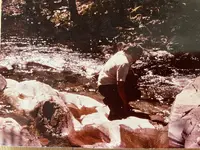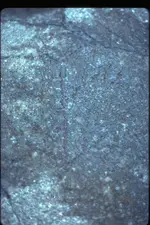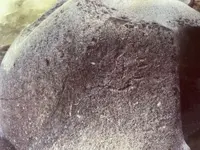Re: previous post There are man yold productive gold mines near this area. The town of Volcanoville is just 4 miles away. An interesting article.

Main menu
Skip to content
COMMUNITY PROFILES
Community Profiles – Small Towns East of Georgetown
by
Doug Noble • September 13, 2013 •
0 Comments

Georgetown Junction at Highway 50
Not many people realize that there was an immigration route from what is now Highway 50, through the back country to Georgetown. It left the main road at Georgetown Junction, near Strawberry, and went through Union (Onion) Valley before heading towards Georgetown. Along it a number of waystations and mining camps evolved over the years.
Many of these small towns and mining communities played a large part in the settlement of the area. Most are gone and some, such as Cement Hill, Gravel Hill, Mt. Gregory and Wolverine Hill, left little if any history of their existence. However, we do know quite a bit about others.
Twelve miles to the east of Georgetown, on Wentworth Springs Road, is the community of
Quintette. John J. Quinn, received a the original land grant for this piece of forest land in 1889.
Almost immediately he sold the land to the Barklage brothers who were timbermen. It is they that started the community of Quintette, which was supported by a logging camp and the Blue Bird Mine.
In 1917 the descendants of the Barklage brothers sold the town to the Douglas family. They acquired more land in the area and turned the first building in the town, the Twelve Mile House, into the Quintette Inn – a popular summer stop for ranchers with cattle summering in the forest. In 1941 the Douglas family sold Quintette, which by consisted of the Quintette Inn, a shed and large barn, to Claude “Bob” Robbins.
The Inn burned in 1945 and was replaced by a cabin. It too burned ten years later and was replaced by another cabin – still known as the Twelve Mile House – that stands today. In 1977, when Bob Robbins was 86 years old, he mysteriously vanished, never to be seen again.
On August 7, 1903 a post office was opened in Quintette, Frederick H. Douglas serving as its first postmaster. It was closed on June 31, 1912, and moved four miles northwest to the town of Virner.
Near, if not at Quintette in the early 1850s was the first inhabited structure that early miners came across once leaving the Placerville Road at Georgetown Junction. This place was known as Works Station, Works Ranch and even Twelve Mile House. It existed as late as 1883, but not much more is known about it.
Between Quintette and Georgetown, on the north side of the road, was
Kentucky Flat, a mining camp between two forks of Otter Creek. In 1854 or 1855, a toll bridge was built over Otter Creek by McCoy and Company, which made travel to and from Georgetown and these communities to the east, much more convenient.
A few miles to the north of Kentucky Flat, on a point overlooking the Middle Fork of the American River was the town of
Volcanoville, which acquired the name because a nearby mountain seemed to be an extinct volcano and the miners had to work through lava cement (a hardened ash/mud deposit) to get to the gold.
In 1852 a rich deposit was discovered at this location and only three years later, a twelve stamp steam-driven mill was in operation, noisily separating the gold from the cement. In 1856 a 42.8 ounce nugget was discovered by a lucky miner and the mining activity increased.
When an 1879 forest fire destroyed most of the buildings in town, a majority of the mines closed. Two years later the Dore (Maurice Dore) Mine was reopened as the Josephine Mine, taking its name from its new owner, Joseph Nouges. By the 1890s the mine was so successful that the town itself was actually renamed Josephine.
The town continued to grow and the Josephine post office was established on August 12, 1895 with store owner Jerome C. Akley as postmaster. The post office would be discontinued on October 20, 1915 and reestablished on July 11 of the next year. It would be closed for good on October 31, 1917.
After the name of the town was changed back to Volcanoville a new post office was opened July 8, 1930 with Mrs. Clara P. Fraser as the first postmaster. It was discontinued on January 31, 1953 and moved to Georgetown.
By the 1960s most everything had shut down an a sign at the entrance to the town read: “Volcanoville. Pop. 4. Elev. 3036.” At that time, Vera Frazier and her son Jim owned the town and operated a museum in a building that has once been a dance hall, general store and saloon. The museum burned in 1969, leaving only a few residences and a beer parlor.
Virner, or
Camp Virner, which was along the road from Quintette to Georgetown was a resort community and, earlier, a mining community. A post office was established there on September 11, 1897 with Janny L. Tuttle as postmaster. On March 31, 1913, the post office was discontinued.
Three miles north of Georgetown was
Bottle Hill, another early mining camp. There are three stories behind why this place was so named.
The first contends that some miners paused here in 1849 while searching for gold and saw a bottle under a bush. Picking it up, they found it was full of whiskey, which they soon consumed. Believing it was an omen, they started mining on the hill, starting the community. The second story mentions some miners coming across a pile of bottles at this location. The third says that the town was named after a nearby bottle shaped hill in the Hornblende Mountains.
No matter how it got its name, Bottle Hill, or Bottle Hill Diggings, was a thriving mining community by 1855, with a book store and express office, run by William T. Gibbs and Sol M. Jinerson, two grocery stores, a boarding house, a post office and the requisite number of saloons. Soon thereafter there were established a division of the Sons of Temperance, with 50 charter members, and a lodge of Know Nothings.
The first and only postmaster for the Bottle Hill Post Office, which opened on May 28, 1855 and closed on August 17, 1859, was Samuel M. Jamison.
Mining continued at Bottle Hill at least until the 1950s.









